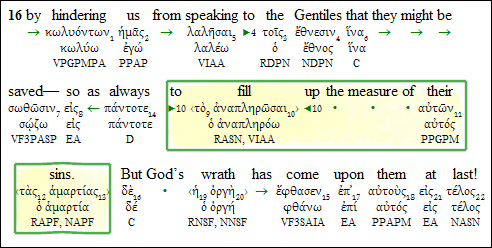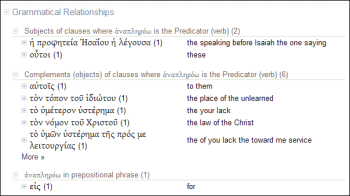It is time for the third installment in our series about the Bible Word Study Report (BWS). Parts 1-3 involved:
- Part I: Running BWS from ESV NT Reverse Interlinear
- Part II: Report Header
- Part III: KeyLinks
To refresh our collective memories, we’re looking at 1Th 2.16. So here it is in the reverse interlinear, with the phrase in question marked up using new Visual Markup features.
The information inside Grammatical Relationships allows you to see the different sorts of words or larger clausal units that are commonly (or uncommonly) used with the study word (in our case, ἀναπληρόω).
Word study isn’t only about what the word means, it is also about how the word is used. The Grammatical Relationships section is the only place, apart from your own syntactic searches and study, where this information is presented to you. And it is done automatically, both in the original language and also, through the bridge of Reverse Interlinears, in English.
So let’s begin our look at the Grammatical Relationships section of the report. There is a lot of information here, so we’ll take two articles to work through it.
If you’ve read the Logos Bible Software Blog for awhile, you may recall an earlier post on the Bible Word Study (BWS) report. And yes, the Grammatical Relationships section has to do with that word that so many people dread: Syntax.
But Grammatical Relationships isn’t about the necessity of thinking proactively concerning syntax. Instead, it uses syntax information to automatically search and return interesting information about relationships that the current study word (in our case, ?????????, ‘fill up the measure of’) has with other words or other syntax-level components.
The Grammatical Relationships section for ????????? returns three sections of hits, as seen below:
Notice that the three sections each contain the original language as we really are querying the underlying original language for grammatical relationships, but they also contain English translations of the original language. (We’ll see more of this in the next blog post when we look into hits; we’re just looking at the sections today).
The three sections with hits listed are:
- Subjects of clauses where ????????? is the Predicator (verb)
- Complements (objects) of clauses where ????????? is the Predicator (verb)
- ????????? in prepositional phrase
There are a number of relationships that could be potentially reported. They are managed in the Properties section of the report. We’ll talk about properties in the series wrap-up post, though. So know that you can configure these and feel free to play with them but we’ll talk about them later.
What do these sections of the report really indicate, though? First, you can hover the section title for an extended description of what exactly is going on in the section. Here’s what happens when we hover the first (the one about the subject):
Here are the descriptions for all of the sections that are listed with the report on ?????????:
Subjects of clauses where ????????? is the Predicator (verb):Lists all of the subjects of clauses where the study word is used as a predicator (verb). Often (but not always) the subject listed will be something or someone that performed the study word as an action. Technically, this query locates clauses that both (1) directly contain a predicator clause component that directly contains a word group that directly contains a head term that directly contains the study word and (2) directly contain a subject clause component as a sibling to the predicator.
Complements (objects) of clauses where ????????? is the Predicator (verb):Lists all of the complements of clauses where the study word is used as a predicator. Often (but not always) the complement of a clause will be the recipient or undergoer of the verbal action, ie, the someone or something to whom the action is done. This section lists roughly those entities that had the study words verbal action done to them. Technically, this query locates clauses that both (1) directly contain a predicator clause component that directly contains a word group that directly contains a head term that directly contains the study word and (2) directly contain a complement clause component as a sibling to the predicator.
????????? in prepositional phrase:Lists prepositional phrases, ordered by preposition, that contain the study word as the object of the preposition. Thus, the query isolates the prepositions used with the study term. Technically, this query selects all words that have sibling modifiers that are specifiers that directly contain prepositions.
Each of the title descriptions may have a few different parts.
- A short description of what the information in the section reflects.This is in many cases a restatement of the title in slightly different language.
- An explanation of the section contents.This is another restatement of the section title, hopefully in language that is a bit more approachable and understandable by those who are unfamiliar with the underlying syntax databases and their terminology. This explains things like: the predicator is the action, the subject is the one doing the action, and the complement is the one receiving the action.
- A technical description using database terminology.This section uses database-specific terminology in another short description. It is usually cued by the keyword “techincally”. The goal of this section is to help users understand how the terminology and components were applied to achieve the results and hopefully help users start to construct their own syntax queries to find even more interesting things within the syntax databases.
After working our way through all of this stuff, we can figure out the following about each section:
- Subjects of clauses where ????????? is the Predicator (verb):These are all of the different words used as the subject (explicitly named person or thing doing the action) where ????????? is the predicator (i.e. verb) used in the clause.
- Complements (objects) of clauses where ????????? is the Predicator (verb):These are all of the different words used as the complement (or object, an explicitly named person or thing that is the recipient of the action) where ????????? is the predicator of the clause.
- ????????? in prepositional phrase:These are all of the prepositional phrases, ordered by preposition, that have ????????? in the prepositional object.
As we learned earlier, the Bible Word Study report helps us learn about what the word means through KeyLinks. We learn about how the word is used by examining what sorts of words or phrases are used along with the study word (?????????). This is done in the Grammatical Relationships section of the report.
So ????????? means something like “make complete” or “fulfill” or “replace”. You begin to understand the nuance of each of those senses by considering who or what is doing ?????????, and to whom or to what ????????? is being done. Grammatical Relationships does all of the heavy lifting for you in searching out these usages, categorizing them, and returning them to you grouped by usage context.
How is this helpful? We’ll see in the next post when we examine some of the hits in the BWS of the
Grammatical Relationships section. Stay tuned!







